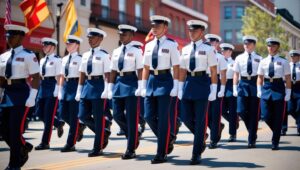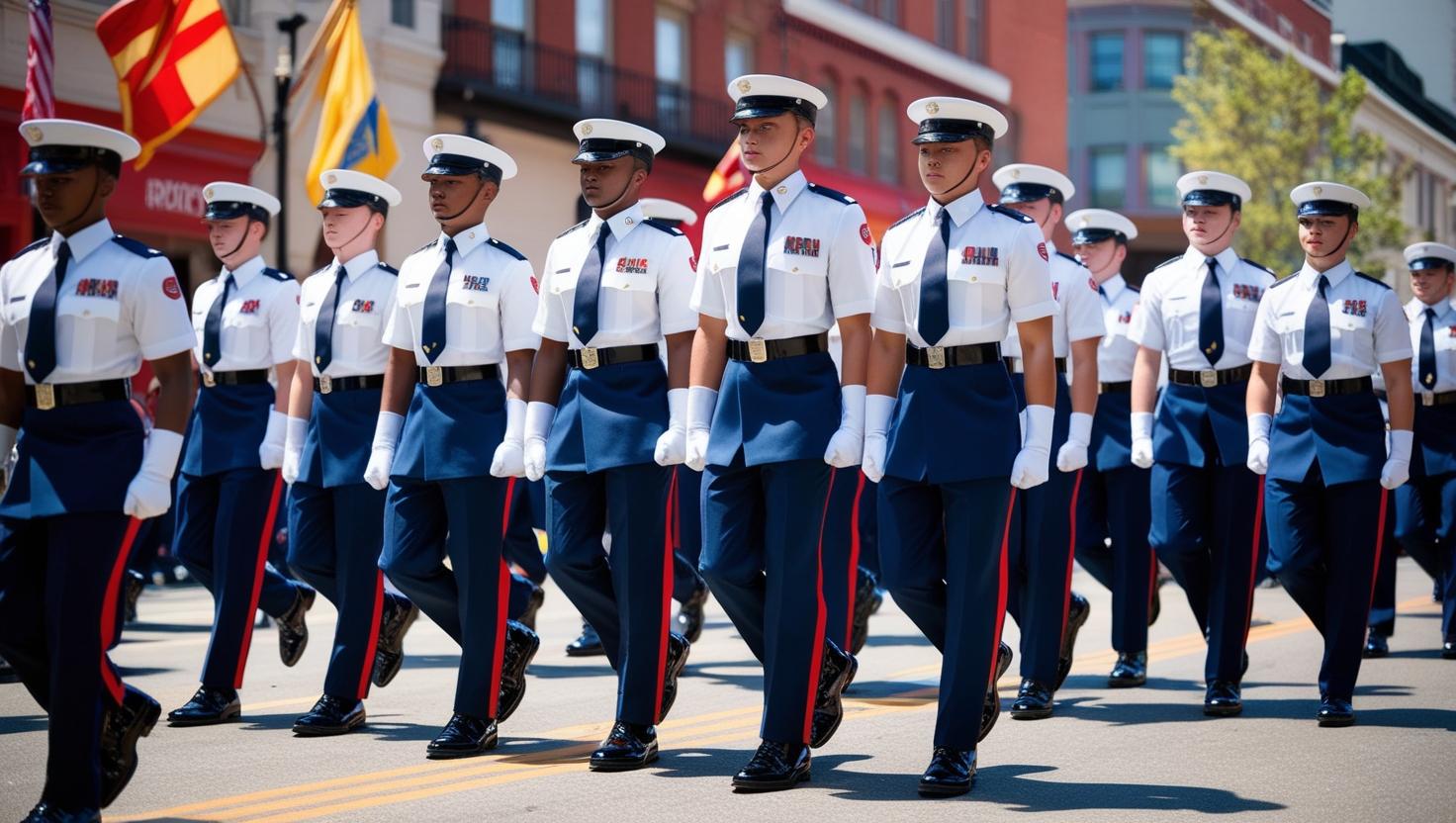
Myth 1: Military schools are only for troubled kids
Where this idea comes from
People sometimes picture cadet schools as correctional programs, a last-resort option when traditional high schools fail. Popular culture and anecdotal stories reinforce that view, which makes parents assume these institutions are punitive placements rather than educational choices.
That narrative sticks because some residential programs historically admitted students needing structure or behavior support. Those cases exist, but they represent only one slice of the landscape.
What the reality usually looks like
Many families choose military academies for positive reasons: leadership training, college preparation, academic rigor, or a structured environment that supports focus and time management. Students arrive with strong transcripts and extracurriculars as often as they arrive with behavioral issues.
Private preparatory academies, public military magnet programs, and service academies all serve different populations. Some emphasize advanced academics and college placement more than discipline for conduct problems.
How to tell if a specific school is corrective or collegiate
Ask about admissions criteria, counseling resources, and the percentage of students admitted for disciplinary reasons. A school that markets leadership academies, AP classes, and college counseling is signaling a different mission than one billed as a “boot camp for teens.”
When I toured a couple of campuses, I met sophomore debate captains and cadets who were top athletes, not just those seeking structure. That variety is common, and it shows how much the term “military school” can mean different things.
Myth 2: Life there is excessively harsh and authoritarian
Why people believe military life is unrelentingly strict
Strict routines, uniforms, and ranks naturally evoke a severe image. Movies and news segments often highlight drills and inspections, so people assume the daily experience is harsh with little room for normal teen life.
Those portrayals tend to focus on extremes because extremes make drama. They do not reflect the nuanced balance many schools aim to achieve between order and personal growth.
Typical balance between structure and nurture
Most schools combine discipline with mentoring, counseling, and extracurricular freedom. Structure is applied to create predictable routines, which many adolescents find comforting rather than punitive.
Discipline in this context is often about accountability: accountability for homework, physical fitness, and commitments to teammates. That framework can help students build habits that serve them in college and careers.
Daily life: what a normal week often contains
A cadet’s week frequently includes classes, study halls, leadership labs, sports or clubs, and community service. Inspections and formations are interspersed with free time and social activities rather than occupying every waking hour.
From conversations with alumni, the most common complaint I heard was about early wake-up times, not about constant punishment. That remark underlines how perception and reality diverge.
Myth 3: Attending a military school forces you into the armed services
Why the confusion exists
Service academies such as West Point or the Naval Academy are famous because they require service commitments, and their visibility blurs the lines for other institutions. People conflate all military-style education with mandatory enlistment.
Also, recruiters and media sometimes highlight pathways to military careers, which can be misread as a requirement rather than an option.
Understanding the range of commitments
Only a subset of institutions are federal service academies that require graduates to accept commission and serve. Many preparatory or secondary institutions do not require military service at all.
Students who wish to pursue the armed services may find certain schools helpful for preparing applications, physical fitness, and leadership qualifications. Others use the experience to strengthen college applications and then choose civilian careers.
How families should evaluate commitment expectations
If you worry about compulsory service, start with the school’s charter and admissions literature. Clear language will state whether there is an obligation to serve after graduation.
Alumni outcomes also tell a story: ask admission officers for the percentage of graduates who enlist, attend service academies, or pursue civilian higher education.
Myth 4: Military schools prioritize discipline over academics and lag behind on teaching
Origins of the academic concern
When discipline is visible, people sometimes assume academics are secondary. The stereotype suggests that time spent drilling or on parades subtracts from classroom instruction.
Those assumptions may come from limited exposure to a few low-resourced programs where academics were indeed weak. They do not describe the broad variety of curriculum quality across the sector.
How academic programs actually compare
Many institutions offer competitive curricula: honors classes, Advanced Placement courses, STEM tracks, and college counseling equivalent to top prep schools. Accreditation and college matriculation lists are good indicators of academic seriousness.
In several schools I visited, cadets took calculus and physics, participated in robotics clubs, and completed community-based research projects. The structured environment often helps students consistently complete homework and develop study habits.
Questions to ask about academic rigor
Request course lists, AP offerings, graduation requirements, and college placement statistics. Ask about teacher credentials, class sizes, and how the school supports students who struggle academically.
Look for strong guidance counseling and partnerships with local colleges. Those features often correlate with academically robust programs that complement, rather than compete with, disciplined environments.
Myth 5: Military schools are only for boys
How historical gender norms shaped perceptions
Historically, many military academies were male-only, which cemented an outdated image. That legacy lingers in public imagination even as institutions have evolved.
Cultural inertia is powerful; once a stereotype takes hold, it can persist long after reality has shifted.
What modern enrollment looks like
Today many cadet programs are coeducational, and women serve with distinction in leadership roles at both secondary military academies and service academies. Female cadets participate in athletics, clubs, and command positions.
For families of daughters, this change matters practically and symbolically. A growing number of schools make explicit commitments to gender equity in admissions, leadership development, and safety policies.
Practical considerations for female students
Ask about female representation among faculty and leadership, restroom and dorm arrangements, and mentorship opportunities. Look for active women’s groups, athletic teams, and alumni networks.
During a campus visit I met several women who credited the environment with giving them confidence in fields traditionally dominated by men. Their stories were persuasive proof that military-style education can be empowering rather than limiting.
Myth 6: Military schools produce robots who lack creativity and individuality
Why the “robot” myth is compelling
The image of uniformity—everyone looking and acting the same—feeds the belief that individual expression is suppressed. Strict dress codes and rank structures make conformity more visible than individuality.
That visible uniformity can mask a variety of personal interests and talents flourishing beneath a common dress code or schedule.
How creativity and individuality are actually nurtured
Many programs intentionally cultivate leadership styles and encourage initiative, critical thinking, and creative problem solving. Cadets lead clubs, produce theater shows, design engineering projects, and write for school publications.
Uniforms and protocols can reduce social pressure about appearance, freeing students to explore identity through ideas, arts, and leadership rather than fashion or peer-culture signaling.
Examples of diverse opportunities
On campus you might find a jazz ensemble rehearsing, a robotics team testing prototypes, and a cadet-run entrepreneurship club meeting in the evening. These activities coexist with military training rather than being excluded by it.
To assess a school’s openness to individuality, examine elective offerings, extracurricular breadth, and whether students hold leadership roles across a range of activities.
Myth 7: Military schools are prohibitively expensive or offer no financial aid
Where the cost assumptions come from
Elite private academies can indeed be costly, and those tuition figures make headlines. That visibility fuels the idea that these schools are out of reach for most families.
At the same time, people conflate private tuition with the broader category, missing public military programs, scholarship-rich institutions, and federal academies that provide fully funded education in exchange for service.
Realistic picture of costs and financial aid
Costs vary widely. Public military magnet schools are tuition-free to local families. Federal service academies provide free tuition but require service commitments. Private schools often offer scholarships, tuition remission, and financial aid based on need.
Many families find that institutional aid, veteran-based scholarships, and payment plans make attendance feasible. Some schools actively market financial support to diversify their student body.
How to evaluate true affordability
Request the financial aid policy, typical award packages, and examples of net-price calculations for families with profiles like yours. Ask about outside scholarships and support for extracurricular costs.
Don’t assume sticker price equals final cost; do the arithmetic. I have seen families surprised by generous aid offers that cut the net price to levels comparable with other private schools.
Common realities across quality programs
Shared strengths worth noting
Across the spectrum, the strongest institutions emphasize leadership development, personal accountability, and a culture of mentorship. Those elements often translate into improved study habits, better time management, and higher college matriculation rates.
Alumni frequently cite lifelong friendships, a strong sense of responsibility, and a clear sense of direction as enduring benefits. These outcomes matter whether a cadet chooses military service or a civilian career.
What differentiates excellent programs from mediocre ones
Strong schools align their mission, curriculum, and student support systems. They hire credentialed teachers, maintain transparent outcome data, and provide robust counseling for academics and mental health.
Mediocre programs may lean too heavily on ritual without offering substantive academic or emotional support. Visiting campuses and speaking with current students are reliable ways to distinguish between the two.
A brief comparison: myths versus reality
| Myth | Reality |
|---|---|
| Only for troubled students | Often chosen for leadership, academics, or structure; varied student populations |
| Always harsh and authoritarian | Balance of discipline and mentoring; structure supports development |
| Forces military service | Only some academies require service; many are preparatory |
| Poor academics | Many offer rigorous curricula and strong college counseling |
| Only for boys | Many coed programs; women play key roles |
| Suppresses individuality | Often fosters diverse interests and leadership |
| Always unaffordable | Wide cost range; scholarships and public options exist |
How to evaluate a military-style school properly
Practical checklist for campus visits
Prepare a list of targeted questions before you go. Ask about academic outcomes, teacher qualifications, student-to-teacher ratios, and how the school measures success beyond disciplinary metrics.
Observe daily rhythms: note how students interact during free time, what activities fill evenings, and whether faculty seem accessible. That observation often reveals more than brochures.
Key documents and statistics to request
Request graduation and college matriculation lists, AP and honors course rosters, accreditation details, and disciplinary policies. Financial aid policies and typical award statistics are also essential.
Ask to speak with the guidance counselor and with a current cadet. Hearing their perspectives on support systems and college advising gives a clearer picture of the institution’s priorities.
Questions that reveal culture
Ask how the school handles failure, mental health, and conflict. Inquire about mentorship programs, community service requirements, and leadership opportunities open to all students.
A healthy culture will demonstrate policies that balance accountability with dignity and provide concrete support for students facing academic or personal challenges.
When military-style education is a strong fit
Typical student profiles that thrive
Students who like predictable routines, those who want explicit leadership training, and those who benefit from structured support often excel in these environments. The setting suits students aiming to build discipline while pursuing rigorous academics.
It can also appeal to families looking for an environment that values service, teamwork, and responsibility, offering a focused alternative to some traditional schools.
When to consider other options
If a student needs complete educational freedom, struggles with authority to the point of defiance, or requires specialized therapeutic interventions not provided on campus, a different setting may be better. Not all needs are met by a uniform approach.
When in doubt, prioritize alignment: the school’s mission, daily life, and support systems should match the student’s goals and temperament.
Final practical tips for families and students
Steps to take after reading this guide
Start by narrowing options based on mission and cost. Visit campuses, talk to current students and staff, and examine academic and post-graduation outcomes. Those steps will separate aspirational marketing from lived reality.
Consider short stays or summer programs to sample life without committing. Many institutions offer trial experiences that give valuable, firsthand perspective.
Questions to leave with admissions officers
Ask about class advisor ratios, remediation policies, mental health services, and how leadership roles are assigned. Request examples of alumni trajectories to understand the long-term impact on careers and education.
Finally, trust what you observe. A school’s promotional material will highlight strengths, but daily life during a visit—how adults treat students, the quality of teaching, and the vibrancy of extracurriculars—reveals the true character of the place.
Myths persist because they are simple and memorable, while real-life decisions are nuanced and messy. Military-style education is not a single thing; it is a family of options ranging from public magnet programs to federally funded academies and private preparatory institutions. For many students, the combination of structure, mentorship, and academic rigor can be transformative. For others, a different environment will be a better fit. Armed with clearer facts and targeted questions, families can move beyond stereotypes and choose the path that best supports a young person’s development.





